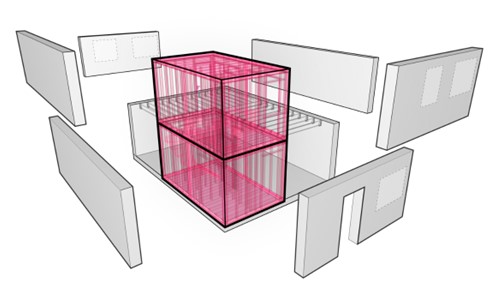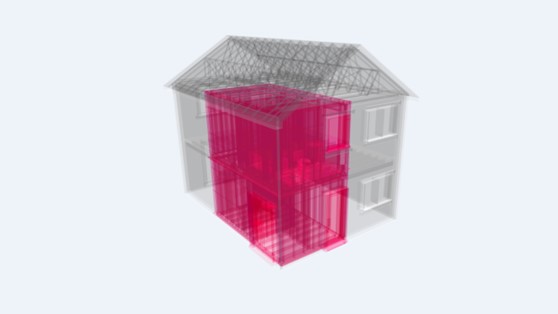In 2019, Michael Gove set the 300,000 homes a year target to tackle the UK’s chronic undersupply of housing. This target has commonly been labelled as ‘unrealistic’ and even ‘impossible’ by many. In this article, Sano explores how hybrid building could be the solution.
Some believe MMC (Modern Methods of Construction) and standardisation is the answer.
However, with a fully volumetric approach, there is simply a limit to how many houses we can produce from a factory setting
This is one of the many reasons why the volumetric approach has yet to be successfully deployed at scale for single-family residential dwellings outside of a few small pockets across the globe.
There is simply a hard limit to how many complete homes can be produced within a modest-sized factory. This is because fully assembled homes simply take up a lot of factory space, unnecessarily.
Perhaps assembling complete living rooms and bedrooms in factories is not the best use of factory space?
Whilst in theory volumetric ticks all the right boxes such as: cost, quality and sustainability, the vast majority of volume builders are still wedded to their traditional methods of construction, and in some cases – rightly so.
Short of building multiple, wildly expensive Tesla-esque Gigafactories, the demand for homes simply cannot be met using this volumetric approach and given the current state of the economy, it is a fair assumption that not many would be willing to take a risk that large on a largely untested concept at scale.

So how can we bridge the gap between off-site and on-site construction?
Hybrid building offers the best of both worlds – offsite standardisation with on-site flexibility in design.
Serial innovators Sano have developed a hybrid building system that combines the strengths of volumetric modular construction with those of other MMC and traditional construction methods – M-Dock.

Within this system, factory-built modules group all the high value spaces and complex building systems together, which are then transported and combined with an on-site built structure containing all the living spaces.
The on-site structure can then be completed using any MMC method, such as panelised, 3D printing, etc. or traditional methods such as brick & block.
The result is that the factory-built module has a high degree of standardisation and repeatability, allowing for higher throughput and superior cost efficiencies without limiting the architectural flexibility of the final build.
Hybrid building enables different house types, styles, and sizes to be built from a standard module pair
Using this approach as an industry, we can produce the standardised modules for thousands of houses at a much higher rate of output – achieving greater and greater levels of economies of scale along the way.
Off-site quality- where it counts
With all the high-value complexities being assembled in a factory rather than constructed on-site, the industry benefits from a high level of quality and productivity that we see in other factory-built products, as seen in the automotive industry.
This applies to Sano’s hybrid system, where quality and repeatability is paramount.
In all the components with historic common points of failure from on-site decisions, for example: the plumbing, bathroom and M&E (Mechanical & Electrical) services, which have the potential to cause severe damage to the house resulting in potential future health risks and costly repairs.
A logistical nightmare – why are we shipping rooms filled with air down the motorway?
Transporting fully assembled living spaces filled with air down the motorway is not sensible nor feasible from a cost, logistics and environmental perspective.
It is also a rather restrictive practice. The size of houses should not be constrained by the size of the transport method or other restrictions such as road widths, bridges, or narrow entries to the site.
Many homes are simply too large for efficient transportation, especially given that approximately 70% is simple living space.
This further supports Sano’s vision of a volumetric system where the simple volume of the house is constructed on-site, and only the factory-built module is to be delivered.
Sano’s factory-less approach – learning from the experiences of Ilke, L&G and others
Traditionally, modular volumetric start-ups look to set up a new factory and mass produce entire homes themselves, rather than take advantage of the highly skilled, specialised individuals and teams that already exist within our industry.
Sano is challenging this status-quo by envisioning a network of assembly partners, not just in the UK, but across the globe.
Simply put, Sano believe the solution is not to build more factories, but to empower the world to make better use of the factory space we already have…
Collaboration should not be avoided; it should be actively embraced.
From concept to reality – Sano’s first collaboration
Partnering with SIPCo, Sano are in the process of building their first test house to put their building system on full display.
This combines their steel framed module with SIPCo’s award winning SIP panels, this house will be ready at the tail-end of September.
Sano are openly inviting any interested parties to arrange a visit to view the test house once it is complete.

















